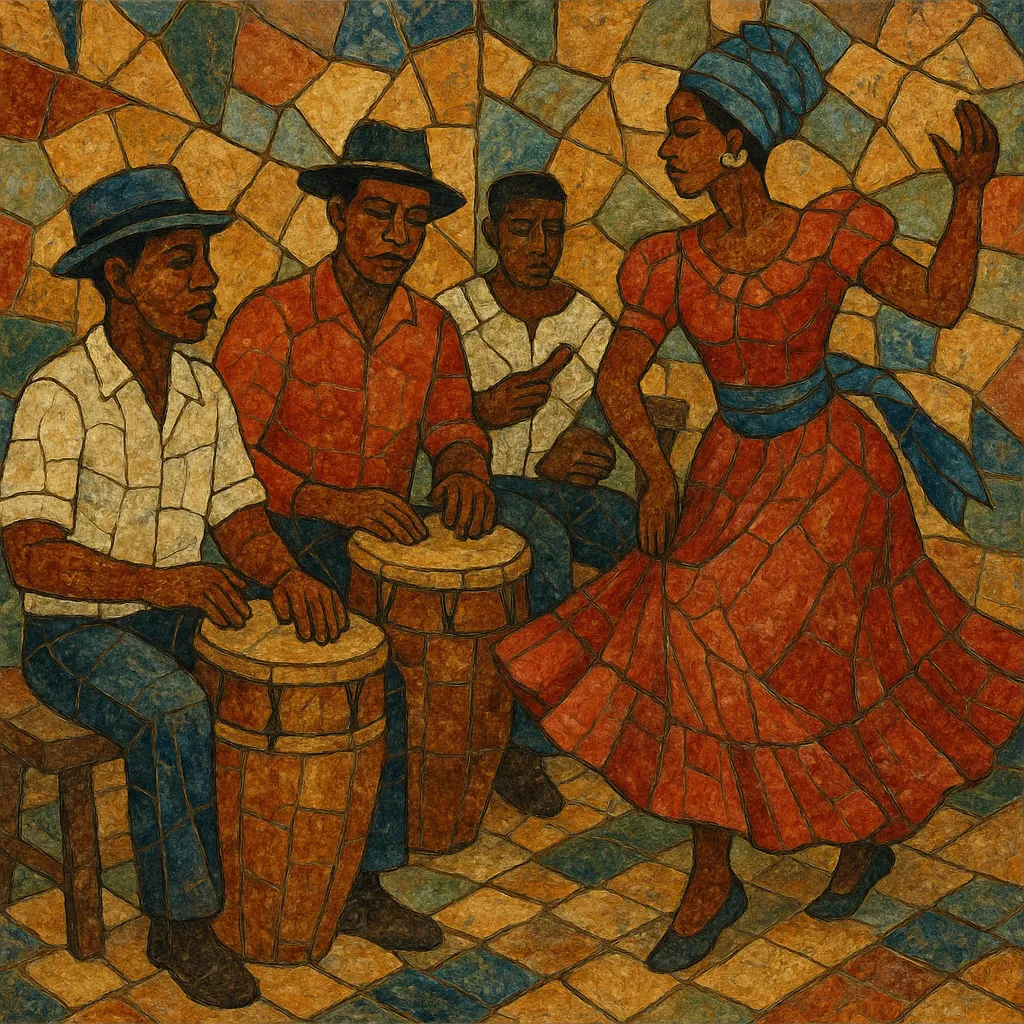Tumba francesa is an Afro‑Creole music and dance tradition that took shape in eastern Cuba (Santiago de Cuba and Guantánamo) after the arrival of Haitian refugees during and after the Haitian Revolution. It blends French colonial contredanse/quadrille figures with Afro‑Haitian drum ensembles and call‑and‑response singing.
Performances feature a lead drum (premièr), supporting drums (segón and bulá), a wooden slit idiophone called catá (also known as tcha‑tcha/catá) and a metal shaker (chachá). Songs are delivered by a lead composer‑singer (composé) and chorus in Haitian Kreyòl and Spanish, while dancers in 18th‑century‑style dress execute set figures (masón) and improvisatory solos (yubá). The result is a stately yet driving dance music that is ceremonial, community‑based, and highly rhythmic.
Tumba francesa emerged in the late 18th and early 19th centuries as planters, free people of color, and enslaved Africans fled Saint‑Domingue (present‑day Haiti) to eastern Cuba during the Haitian Revolution (1791–1804). They brought French ballroom dance forms (contredanse/quadrille) and Afro‑Haitian ritual and social drumming practices, which mingled with local Afro‑Cuban traditions in the Oriente region.
Through the 19th century, the practice organized around mutual‑aid and cultural clubs known as sociedades de tumba francesa. These institutions preserved repertories, instruments, costumes, and ceremonial roles. Core musical suites crystallized around rhythms like masón (linked to figure dancing derived from contredanse) and yubá (a slower, more improvisatory context for solo dance and expressive drumming).
Urbanization and the rise of newer Cuban dance genres (son, danzón, later rumba styles and popular music) reduced public presence, but eastern‑Cuban communities maintained the tradition. From the mid‑20th century, folkloric ensembles and researchers helped document and re‑present tumba francesa on stage, while the original sociedades continued community practice.
Today, groups such as La Caridad de Oriente, Santa Catalina de Ricci, and Pompadour maintain living lineages. Tumba francesa is recognized as an emblem of Afro‑Haitian Cuban heritage and has been highlighted by cultural institutions and festivals. Contemporary performances balance ceremonial community functions with staged presentations, safeguarding language (Kreyòl/Spanish), dance figures, and instrument techniques.
Use a three‑drum ensemble: premièr (lead/solo drum), segón (middle/time‑keeping), and bulá (ostinato/support). Add a catá (wooden slit idiophone) articulating the core timeline, and a metal chachá (shaker) for texture. Hand technique and responsive improvisation on the premièr are essential.
Base pieces on two principal suites: masón for figure dancing (derived from contredanse) with brisk, square phrases; and yubá for slower, weightier solo dancing with freer phrasing. Emphasize cyclical ostinati, cross‑rhythms (2:3 and 3:2), and patterns akin to tresillo/cinquillo. Keep the catá timeline steady as the rhythmic spine.
Write short call‑and‑response verses led by a composé, answered by a chorus. Use Haitian Kreyòl (often mixed with Spanish) and thematic texts honoring ancestors, community, and ceremonial occasions. Melodic range is moderate; delivery is declamatory and rhythmic to interlock with the drums.
Choreograph figure sequences (masón) with couples in formal 18th‑century‑style attire, and feature soloists in yubá sections. Cue dancers with vocal calls and drum breaks. Maintain ceremonial decorum: entrances, salutes, and processional elements frame the performance.
• Start with catá and chachá timeline, layer bulá and segón ostinati, then bring in premièr improvisations.
• Insert short breaks (paradas) for dance cues and vocal interjections.
• Keep dynamics alive: masón sections are brighter and driving; yubá sections are deeper, with spacious drum dialogue.


